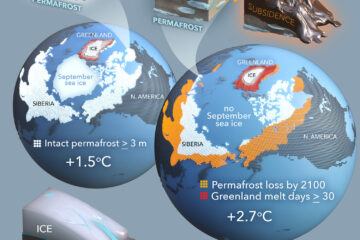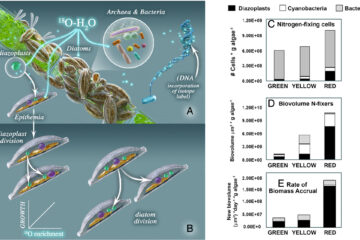Ecogeomorphic feedbacks in regrowth of travertine step-pool morphology after dam decomissioning, Fossil Creek, Arizona
The linkages between fluvial geomorphology and aquatic ecosystems are commonly conceptualized as a one-way causal chain inwhich geomorphic processes create the physical template for ecological dynamics. In streams with a travertine step-pool morphology, however, biotic processes strongly influence the formation and growth of travertinedams, creating the potential fornumerous feedbacks.Herewetakeadvantage of the decommissioning of a hydroelectricproject on Fossil Creek,Arizona,where restoration of CaCO3-rich baseflowhas triggered rapid regrowth of travertine dams, to explore the interactions between biotic and abiotic factors in travertine morphodynamics. We consider three conceptual frameworks, where biotic factors independently modulate the rate of physical and chemical processes that produce travertine dams; combinewith abiotic factors in a set of feedback loops; handwork in opposition to abiotic processes, such that the travertine step-pool morphology reflects a dynamic balance between dominantly-biotic constructive processes and dominantly-abiotic destructive processes. We consider separately three phases of an idealized life cycle of travertine dams: dam formation, growth, and destruction by erosive floods. Dam formation is catalyzed by abiotic factors (e.g. channel constrictions, and bedrock steps) and biotic factors (e.g. woody debris, and emergent vegetation). From measurements of changes over time in travertine thickness on a bedrock step, we find evidence for a positive feedback between flow hydraulics and travertine accrual. Measurements of organic content in travertine samples from this step show that algal growth contributes substantially to travertine accumulation and suggest that growth is most rapid during seasonal algal blooms. To document vertical growth of travertine dams, we embedded 252 magnets into nascent travertine dams, along a 10 km stretch of river. Growth rates are calculated from changes over time in themagnetic field intensity at the dam surface. At each magnet we record a range of hydraulic and travertine composition variables to characterize the dominant mechanism of growth: abiotic precipitation, algal growth, trapping of organic material, or in situ plant growth.We find: (1) rapid growth of travertine damsfollowingflowrestoration, averagingmore than 2 cm/year; (2) growth rates decline downstream, consistent with loss of dissolved constituents because of upstream travertine deposition, but also parallel to a decline in organic content in dam surface material and a downstream shift in dominant biotic mechanism; (3) biotic mechanisms are associated with faster growth rates; and (4) correlations between hydraulic attributes and growth rates are more consistent with biotic than abiotic controls.We conclude that the strong influence of living organisms on rates of travertine growth, coupled with the beneficial effects of travertine on ecosystem dynamics, demonstrate a positive feedback between biology and geomorphology. During our two-year study period, erosive flood flows occurred causing widespread removal of travertine. The temporal distribution of travertine growth and erosion over the study period is consistent with a bimodal magnitude– frequency relation in which growth dominates except when large, infrequent storms occur. This model may be useful in other systems where biology exerts strong controls on geomorphic processes.


